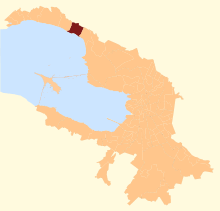Repino, Saint Petersburg
Coordinates: 60°10′N 29°52′E / 60.167°N 29.867°E


Repino (Russian: Ре́пино) is a municipal settlement in Kurortny District of the federal city of St. Petersburg, Russia, and a station of the Saint Petersburg-Vyborg railroad. It was known by its Finnish name Kuokkala until 1948, when it was renamed after its most famous inhabitant, Ilya Repin. It is located approximately 30 kilometers (19 mi) northwest of St. Petersburg proper,[1] on the Karelian Isthmus on the shore of the Gulf of Finland. Population: 2,478 (2010 Census);[2] 2,011 (2002 Census);[3] 4,215 (1989 Census).[4]
The settlement is known for Repin's estate Penaty and for its sanatorium.
History
At the beginning of the 20th century, Repino (then Kuokkala) was located in the Grand Duchy of Finland, a part of the Russian Empire. Shortly after the October Revolution in 1917, Finland declared its independence from the Soviet Union. When the Karelian Isthmus was ceded by Finland to the Soviet Union after the Winter War and the Continuation War (1939–1944), Kuokkala became Russian. In 1948, it was renamed Repino in honor of the painter Ilya Repin.[1]
Penates

In 1899, Repin bought an estate here and called it Penaty (Russian: Пенаты, meaning Penates, Roman household gods). He designed his own house, and after it had been built several years later, Repin moved to Kuokkala. He would live there until his death in 1930. The house is surrounded by a large park.
The estate is part of the UNESCO World Heritage Site Saint Petersburg and Related Groups of Monuments.[5] The estate has been a museum since 1940.[6]
Famous inhabitants
- Mikhail Botvinnik, World chess champion, was born in Kuokkala in 1911.
- Vladimir Lenin, Russian Communist leader and founder of the USSR, lived in Kuokkala between 1906 and 1907.
- Ivan Puni, avant-garde artist, was born in Kuokkala in 1894.
- Ilya Repin, painter and sculptor, lived in Kuokkala from the beginning of the 20th century until his death in 1930.
- Korney Chukovsky, children's poet and philologist, lived in Kuokkala from 1906 till 1916.
- Elena Mrozovskaya, an early female photographer, died in Kuokkala in 1941.[7]
Notes
- 1 2 (German) Petersburg-Aktuell, "Repino: Zu Gast beim großen Meister", retrieved on 25 May 2007.
- ↑ Russian Federal State Statistics Service (2011). "Всероссийская перепись населения 2010 года. Том 1" [2010 All-Russian Population Census, vol. 1]. Всероссийская перепись населения 2010 года (2010 All-Russia Population Census) (in Russian). Federal State Statistics Service. Retrieved June 29, 2012.
- ↑ Russian Federal State Statistics Service (May 21, 2004). "Численность населения России, субъектов Российской Федерации в составе федеральных округов, районов, городских поселений, сельских населённых пунктов – районных центров и сельских населённых пунктов с населением 3 тысячи и более человек" [Population of Russia, Its Federal Districts, Federal Subjects, Districts, Urban Localities, Rural Localities—Administrative Centers, and Rural Localities with Population of Over 3,000] (XLS). Всероссийская перепись населения 2002 года [All-Russia Population Census of 2002] (in Russian). Retrieved August 9, 2014.
- ↑ Demoscope Weekly (1989). "Всесоюзная перепись населения 1989 г. Численность наличного населения союзных и автономных республик, автономных областей и округов, краёв, областей, районов, городских поселений и сёл-райцентров" [All Union Population Census of 1989: Present Population of Union and Autonomous Republics, Autonomous Oblasts and Okrugs, Krais, Oblasts, Districts, Urban Settlements, and Villages Serving as District Administrative Centers]. Всесоюзная перепись населения 1989 года [All-Union Population Census of 1989] (in Russian). Институт демографии Национального исследовательского университета: Высшая школа экономики [Institute of Demography at the National Research University: Higher School of Economics]. Retrieved August 9, 2014.
- ↑ Unesco World Heritage Site Saint Petersburg and Related Groups of Monuments, retrieved 25 May 2007.
- ↑ Info on the museum "Penates", retrieved 25 May 2007.
- ↑ Pachmuss, Temira (1992), A moving river of tears: Russia's experience in Finland, American university studies: Slavic languages and literature, 15, P. Lang, p. 173, ISBN 9780820419565,
Elena Lukinichna Mrozovskaya, an artistic photographer in St. Petersburg, had a house in Vammelsuu in the 1920s; in 1941 she died in Kuokkala, after the Soviet-Finnish War of 1939-40.
.png)
